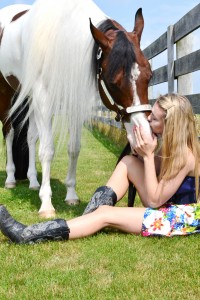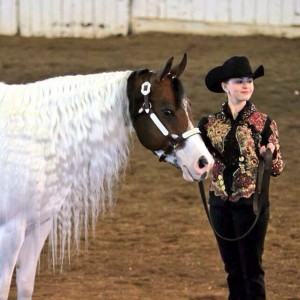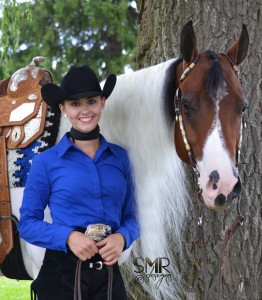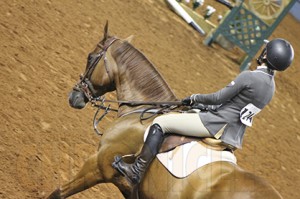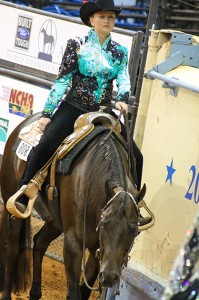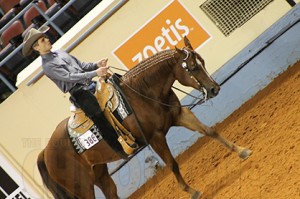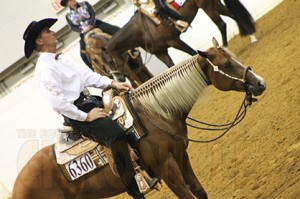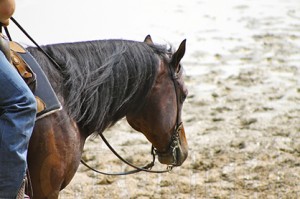Long Manes in All-Around Events, A Do or Don’t?
By: Brittany Bevis
Trends in horse show grooming vary widely based on discipline, a horse’s age, and personal taste. Some have ties to different generations; our more “seasoned” competitors might remember a time when roached manes and docked tails were all the rage… Today, the most common sight on major breed circuits is a neat two-three inch mane that’s banded for western events and braided for english. However, in recent years, more show horses have been seen sporting long, flowing locks.
As every horse approaches that inevitable two-year-old mark, there is one question that must be asked. To cut or not to cut. For APHA/PtHA competitor, Brandy Smith, of Findlay, Ohio, the answer was simple.
Smith is the owner of Struttin My Assets, aka “Charlie,” a 15.1 hand, bay tobiano gelding that was bred, raised, and trained on her family’s farm. Aside from his talent in western all-around events, Charlie is well-known for his signature, snow white mane that reaches well past his forearm. It hasn’t been cut for six years.
“His mother was my walk-trot horse, and I have owned Charlie from birth,” Smith says. “Getting to show a horse that is homebred, and especially the bond I had with his mother, is so rewarding and fulfilling. It makes success very sweet when you know you made everything happen.”
Smith does all of Charlie’s training herself with the help of her father and horse trainer, Mark Smith. As a result, Charlie is a multiple World and Reserve World Champion in events like western pleasure, equitation, and even speed.
“He is a true all-arounder who will show all day long in every class successfully and still run a 17 second barrel pattern at the end of the day,” she says. “No matter what I ask him to do, he will try his heart out and still have a good attitude no matter what. I’m completely in love with him, and he has a home for life.”
The decision not to chop Charlie’s coveted curls came when he was first started under saddle.
“His mane was already just so long, thick, white and soft, and I couldn’t bring myself to cut it,” she says. “I kept saying I would wait until right before the first show. The first show rolled around and my dad and I decided we would give the long mane thing a try, since he was just doing pleasure and I’m always one to try new things and be different.”
“I went to more and more shows, got more and more complements, and it just got prettier and prettier. I finally decided that I would never be able to cut it; it would break my heart. He was going to be the first all-around Paint Horse with a long mane, and I didn’t care what other people thought about it. The rest is history.”
At the larger horse shows, Smith does tame Charlie’s mane just a bit with a neat row of double bands, basket weave design, or a single row of contrasting bands. She’s also been known to utilize a running braid for classes such as halter, showmanship, and equitation “to create a slightly cleaner look for the more reserved classes.”
Smith has encountered some naysayers who insist that a serious show horse should have a short mane. However, for the most part, she and Charlie have received a positive response to their decision to go au natural.
“Most people think it is gorgeous and unique and defines Charlie,” she says. “They like that he is bringing back the long mane and having success with it.”
“There are some trainers who chase me around horse shows with scissors and say if I want to be competitive, I have to cut it. I personally pay them no mind. I usually have at least one judge every show come up to me and say something about his mane and how unique and cool it is to see that back in the arena and not to cut it. There are some judges who seem to look past him and give us very little credit in classes, because the long mane isn’t the normal look, but they are the minority.”
This type of beauty doesn’t come without a price; it requires a lot of maintenance. Smith gave her top tips for keeping long manes in show ring shape.
“I keep it braided in five long braids at all times when we aren’t showing,” she says. “It gets washed, conditioned, and rebraided as sparingly as possible; only for shows or once a month. I use a variety of sprays to keep it healthy such as Healthy Hair Care, Canter Mane and Tail, and Jack Be Nimble Conditioner. Also, I comb as sparingly as possible. To keep it white, I use salon quality whitening shampoo meant for women’s white hair, wash with hot water, and I try to wash out manure stains ASAP when they happen so they don’t set.”
“I always keep it braided, except for in the show ring. If his mane gets tangled, it’s so long and soft and fine, I can’t untangle it without pulling out large quantities of hair. I have found that the hair that comes out during braiding/unbraiding is less than the alternative.”
Although there’s no question that Charlie’s mane is stunning, we wondered if Smith ever thinks about whether his long locks might be a distraction in certain classes.
“I do not,” she says. “I think a good pattern is a good pattern, and a judge should not be judging my horse’s mane. I think it’s definitely a trend that’s coming back. I receive so many emails and Facebook messages from people asking me about his mane and how much they love it and how they want to grow their horse’s mane out after seeing his.”
“I think as long as the mane suits the horses, looks clean and cared for, and is presented in the proper manner, they can be so unique and set you apart. I know I was one of the first in the Paint industry to leave a mane long for the all-around events, and I have not regretted my decision.”
What’s your opinion? Are you still in favor of the short look, or are you eager to start growing out your horse’s mane?
Scroll below to see photos of a few horses we’ve seen sporting long manes at horse shows like the AQHYA World Show, AQHA World Show, Tom Powers Futurity, and All American Quarter Horse Congress.










